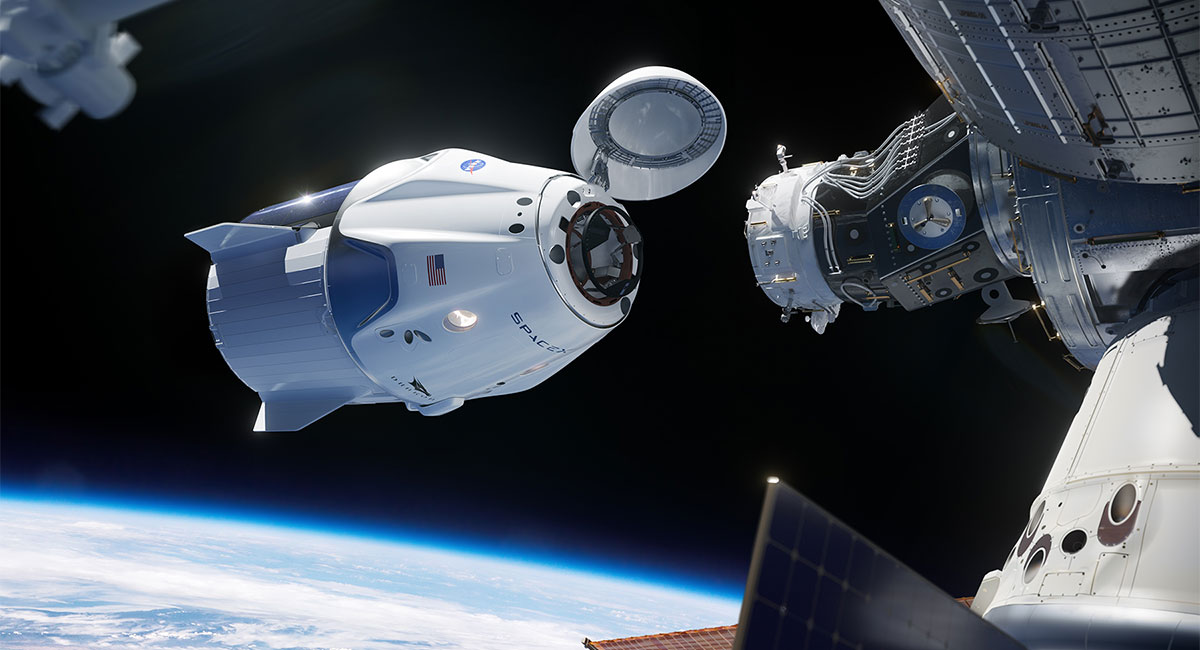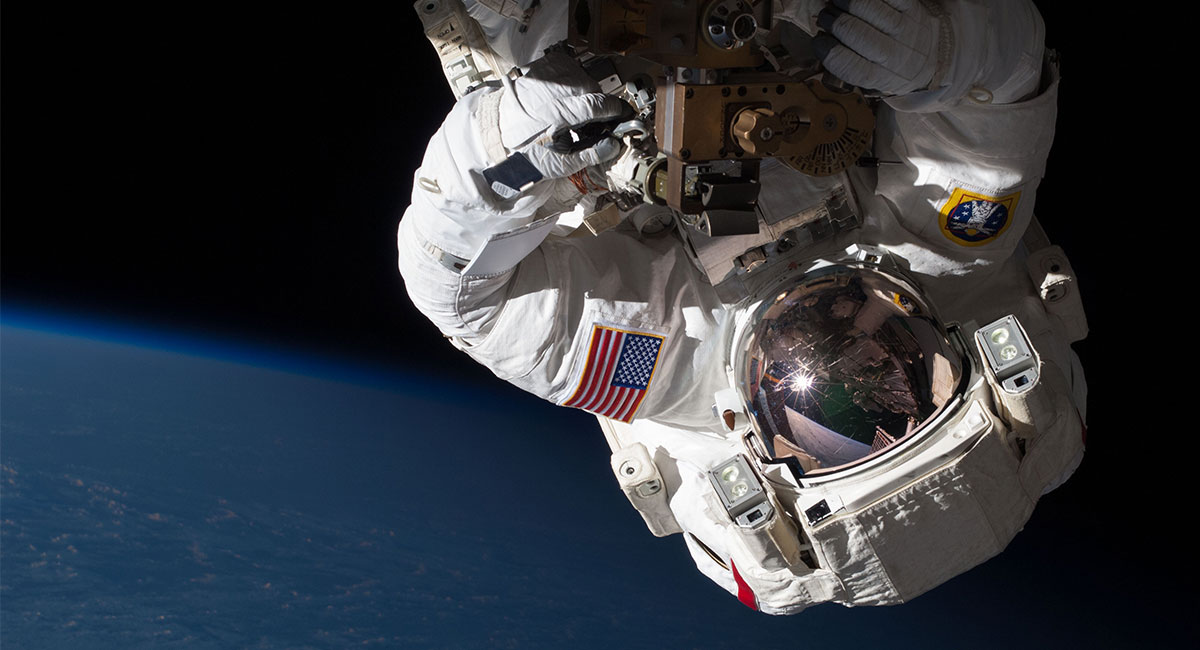scenes from outer space
Supplying Outer Space
Moore School researchers apply management principles to emerging space industry
Getting spare parts in space is no easy task. What if an astronaut on the International Space Station needs to replace a wrench that has accidentally floated away? It’s not like he or she can just order one and have it delivered in two days via Amazon Prime. But the first commercial manufacturing service in space — Made in Space — has the answer. Made in Space installed a 3D printer on the International Space Station in 2014 and now manufactures tools, devices and parts for the crew while in orbit.
Space is increasingly becoming the province of private enterprise. With growing private investment and a developing private commercial industry, space is also becoming in some sense just another place to do business.
With that realization also comes the need to address the same operations management and supply chain issues that businesses face on Earth, says Joel Wooten, assistant professor of management science at the Darla Moore School of Business. Operations management is a field of how to get things done. But how do you get things done in space? While the issues are the same, the problems are often greatly magnified.
Wooten and Christopher S. Tang, Distinguished Professor and Edward W. Carter chair in business administration at UCLA, recently co-authored “Operations in Space: Exploring a New Industry.” The paper, which appeared in Decision Sciences, outlines operations management research opportunities in the emerging space industry. Wooten and Tang highlighted “opportunities for operations researchers in three categories: manufacturing operations, supply chain management and sustainable operations.” They also identified four types of challenges — distance, gravity, inhospitable environments and information — in each area.
In terms of distance, the farthest we’ve been from Earth is just to other side of the moon, and it is not that far.
“Think about traveling to Mars,” Wooten says. “Instead of driving across town, you now have to drive to Texas.” But to cover those enormous distances requires first escaping Earth’s gravity, which costs a lot of money.
“That means pizza delivery to the International Space Station is off the table.”
The inhospitable environment of space poses its own challenges for doing business. Humans need air, water and food to survive, and those are either nonexistent, sparse or inaccessible. Man must also grapple with the health concerns of being in space, such as exposure to radiation and lack of gravity.
Having accurate information is key to successful space operations. For example, Wooten and Tang point out that space “navigation is in its infancy and currently relies on Earth-bound equipment.”

Unlike most academic papers, which generally define a problem and then either solve the problem or propose a solution, Wooten says the co-authors wanted to inspire researchers and help give them a roadmap for all the questions that need answering and a framework for how to do that within operations management. Like space itself, the questions, the opportunities and the problems are boundless.
The impetus for the paper came from Wooten, whose research focuses on innovation and entrepreneurship. An adviser with XPRIZE on its space contests, Wooten attended the White House Frontiers Conference in 2016 in the Interplanetary Track.
“I feel like I’m pretty up-to-date with science and technology, and I was hearing things that I didn’t even know NASA was focused on,” Wooten says. One thing that Wooten came away from the conference with is the feeling that the timeline for a manned mission to Mars is shorter than most people think.
“I think 10 years from now, there are developments that make the space industry look very different. Whether that is the Chinese Space Agency program putting up their own space station — which is a possibility that they are working toward, might be two or three years out — or a lunar colony that has been talked about as precursor to a mission to Mars,” he says.
In late 2017, NASA refocused some of the programs under its Journey to Mars initiative into returning astronauts to the moon in preparation for a human mission to Mars.
But, once the domain of national governments, space exploration is becoming more and more the province of a commercial space industry.
“And one of the things that you see with this privatization is that space is becoming in some sense just another place to do business,” Wooten says. “I started thinking that all the things we know in operations management — they apply to this new realm. But basically, we’ve looked at all of this stuff on Earth. And that’s a particular environment that we know pretty well. We’ve lived here at long time. But once you expand that, do those same principles hold?”
Wooten and Tang note that firms like SpaceX, Blue Origin, Virgin Galactic, Sierra Nevada and Rocket Lab now develop different spacecraft. Firms like Made in Space, Planetary Resources and Deep Space Industries now develop manufacturing and resource capabilities for space. Companies such as NanoRacks and Astrobotic are positioned as logistics facilitators for payloads and launches.
In the manufacturing realm, firms like Made in Space are now working on how to manufacture and assemble very large structures in space.
“They are going to build robots that can build a space station out in space, or build satellite dishes,” Wooten says.
Man won’t be limited to sending something into space that fits into a rocket. Assembling the International Space Station took lots of pieces, but they all had to fit into a rocket and withstand the g-force of takeoff.
“Now you print delicate structures and build them right there, and they can be as big as a football field. You want to build a huge antenna to communicate with Mars? We’ll just build it right out in space. So that is opening up new ways of operating, which solves different problems,” Wooten says.

Companies like Elon Musk’s SpaceX are becoming the FedEx of space, with rockets that go up regularly to resupply the International Space Station or deploy satellites, and they are pushing the technology forward for reusable rockets — rockets that land themselves. But those rockets can have empty spots in their cargo bays.
“Other companies are saying, ‘Researcher at university XYZ, you want to run an experiment in space? Here are the dimensions for what you can do. Build it and we’ll take it from you and get it to space,’” Wooten says. Those companies are becoming the intermediaries between the researchers and SpaceX, or SpaceX and private citizens who just want to send things up and see what happens.
The prospect of rockets delivering cargo to space and then returning to land on Earth conjures up other possibilities. In addition to manufacturing items in space for use in space, firms are looking at what can be manufactured better in space for use on Earth.
Wooten cites the example of fiber optic cable. Fiber optic cable manufactured on Earth is good and it’s really fast, but it has impurities in it, just because of the atmosphere.
“When you do that in a zero-gravity environment with no particulates, you can create perfect fiber cable that is orders of magnitude better and faster,” Wooten says. “We can move that production to space and spool it up there and send it back on rockets that are coming back because they are empty. So instead of coming back empty, they are coming back holding a commercial product, and that is a win-win for everybody.”
Other companies are thinking about mining in space. Can rare materials be mined on asteroids? Can we go to the moon and harvest Helium-3, a rare element that has the potential to solve the energy crisis?
“There are all these companies that are starting to push out from Earth, and that is changing the whole connect-the-dots sequences of businesses and processes, because before it was NASA. NASA went up and did what they wanted, and they came back. And we reported on it and watched,” Wooten says.
But that has changed.
So instead of coming back empty, they are coming back holding a commercial product, and that is a win-win for everybody.
“The expanding space industry features new firms and governments contributing to the space economy,” Wooten and Tang write.
They point to the Indian Space Research Organization, which “went to thousands and thousands of these small mom-and-pop shops and said, ‘Hey, we need this from you.’ That looks very different from a single, consolidated organization’s perspective.
So, I think you will see more of that as more and more countries or entities or companies access space,” Wooten says.
And as more companies become part of the space industry, Wooten says that risk is one of the most important issues, if not the most important issue.
“You do something, and some element is going to fail. So then how do you grapple with that risk when you are talking about human lives and investment, infrastructure and assets? What level is acceptable for each? How do you build out a plan or an operations structure that minimizes that? Because historically that would mean lots of redundancies. But that is really expensive.”
SpaceX, Wooten says, is probably a good example of rapidly pushing technology forward to minimize risk.
“I think Elon Musk gave the Falcon Heavy Rocket a 50/50 chance of blowing up, and it turns out it did great, and that is wonderful. But it is a very different story if it explodes on the launch pad.”
That the world’s most recognized space entrepreneur placed coin-flip odds on successfully propelling his latest innovation off Earth perfectly captures the challenges ahead. Getting things to space is no easy task, and the business of figuring out how to operate in that environment is just taking off.

Photos and video courtesy of NASA.